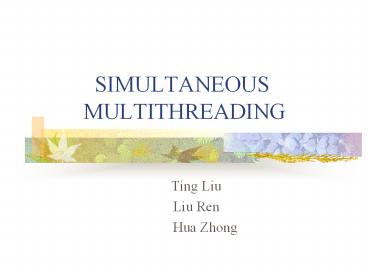SIMULTANEOUS MULTITHREADING - PowerPoint PPT Presentation
1 / 13
Title:
SIMULTANEOUS MULTITHREADING
Description:
SMT Architecture(2) Need large register files, longer register access time, pipeline stages are added.[Register reads and writes each take 2 stages.] – PowerPoint PPT presentation
Number of Views:177
Avg rating:3.0/5.0
Title: SIMULTANEOUS MULTITHREADING
1
SIMULTANEOUS MULTITHREADING
- Ting Liu
- Liu Ren
- Hua Zhong
2
Contemporary forms of parallelism
- Instruction-level parallelism(ILP)
- Wide-issue Superscalar processors (SS)
- 4 or more instruction per cycle
- Executing a single program or thread
- Attempts to find multiple instructions to issue
each cycle. - Thread-level parallelism(TLP)
- Fine-grained multithreaded superscalars(FGMS)
- Contain hardware state for several threads
- Executing multiple threads
- On any given cycle a processor executes
instructions from one of the threads - Multiprocessor(MP)
- Performance improved by adding more CPUs
3
Simultaneous Multithreading
- Key idea
- Issue multiple instructions from multiple
threads each cycle - Features
- Fully exploit thread-level parallelism and
instruction-level parallelism. - Better Performance
- Mix of independent programs
- Programs that are parallelizable
- Single threaded program
4
Superscalar(SS)
Multithreading(FGMT)
SMT
Issue slots
5
Multiprocessor vs. SMT
Multiprocessor(MP2)
SMT
6
SMT Architecture(1)
- Base Processor like out-of-order superscalar
processor.MIPS R10000 - Changes With N simultaneous running threads,
need N PC and N subroutine return stacks and more
than N32 physical registers for register
renaming in total.
7
SMT Architecture(2)
- Need large register files, longer register access
time, pipeline stages are added.Register reads
and writes each take 2 stages. - Share the cache hierarchy and branch prediction
hardware. - Each cycle select up to 2 threads and each fetch
up to 4 instructions.(2.4 scheme)
Fetch Decode Renaming Queue Reg Read Reg Read Exec Reg Write Commit
8
Effectively Using Parallelism on a SMT Processor
Parallel workload Parallel workload Parallel workload Parallel workload Parallel workload Parallel workload
threads SS MP2 MP4 FGMT SMT
1 3.3 2.4 1.5 3.3 3.3
2 -- 4.3 2.6 4.1 4.7
4 -- -- 4.2 4.2 5.6
8 -- -- -- 3.5 6.1
Instruction Throughput executing a parallel
workload
9
Effects of Thread Interference In Shared
Structures
- Interthread Cache Interference
- Increased Memory Requirements
- Interference in Branch Prediction Hardware
10
Interthread Cache Interference
- Because the share the cache, so more threads,
lower hit-rate. - Two reasons why this is not a significant
problem - The L1 Cache miss can almost be entirely covered
by the 4-way set associative L2 cache. - Out-of-order execution, write buffering and the
use of multiple threads allow SMT to hide the
small increases of additional memory latency. - 0.1 speed up without interthread cache miss.
11
Increased Memory Requirements
- More threads are used, more memory references per
cycle. - Bank conflicts in L1 cache account for the most
part of the memory accesses. - It is ignorable
- For longer cache line gains due to better
spatial locality outweighted the costs of L1 bank
contention - 3.4 speedup if no interthread contentions.
12
Interference in Branch Prediction Hardware
- Since all threads share the prediction hardware,
it will experience interthread interference. - This effect is ignorable since
- the speedup outweighted the additional latencies
- From 1 to 8 threads, branch and jump
misprediction rates range from 2.0-2.8 (branch)
0.0-0.1 (jump)
13
Discussion
- ???































